As my comparative test of the EF and RF versions of the 24-105 f/4L IS on the Canon EOS R5 showed that the RF is better, I have meanwhile sold my EF 24-105, which has been hardly used in recent times anyway, to good hands via eBay. But even though the RF 24-105 f/4L IS is better than the EF version, I wondered if there was a better option in the very frequently used focal length range, at least up to 70mm. For the range above that, I still own the excellent EF 70-200 f/2.8L IS II. Because of the faster speed, I’ve been flirting with an RF 24-70 f/2.8 IS - but up to now it’s been far too expensive for me.
By the way: More information about the Canon EOS R5 and EF lenses can be found in my detailed article Initial experiences with the new Canon EOS R5 and in many other articles on this website.
However, must it be a RF mount lens?
As I already own a large zoo of high-quality EF lenses, I already have very good experience with adapting EF lenses (especially with the option of using filters in the EF-EOS R drop-in filter mount adapter). Furthermore, I also want to continue using my EOS 5DSR, so I am still very interested in EF lenses. In addition, many Canon photographers are currently migrating to RF lenses after switching to the new EOS R5 or R6 bodies and often ” dump” their old EF lenses well below value, so there must still be some bargains to pick up?
I then stumbled across a very attractive offer for a 24-70mm f/2.8L II on eBay (here are some current offers for the lens on eBay*) again and snapped it up. In total, I only paid about 1/3 of the price of an new RF 24-70 f/2.8L IS for the lens. Optically, both versions are comparably very good, as can be seen, for example, in the comparison at the-digital-picture.com. Also, I thought that on the Canon EOS R5 or R6, the built-in sensor stabilizer could compensate to some extent for the RF version’s lack of an optical IS. In addition, I can still use the EF lens on my 5DSR.
The EF 24-70 f/2.8L II is about the same size as the RF (about 5mm longer and wider, about 100g heavier). It has an 82mm filter thread, the RF comes with 77mm, as does my EF 16-35 f/4L IS and my EF 70-200 f/2.8L IS II. Below, I’ve photographed it with the mounted drop-in filter mount adapter EF-EOS R* in comparison to the RF 24-105 f/4L, which makes it look significantly longer, and also makes it more than 200g heavier than the RF:
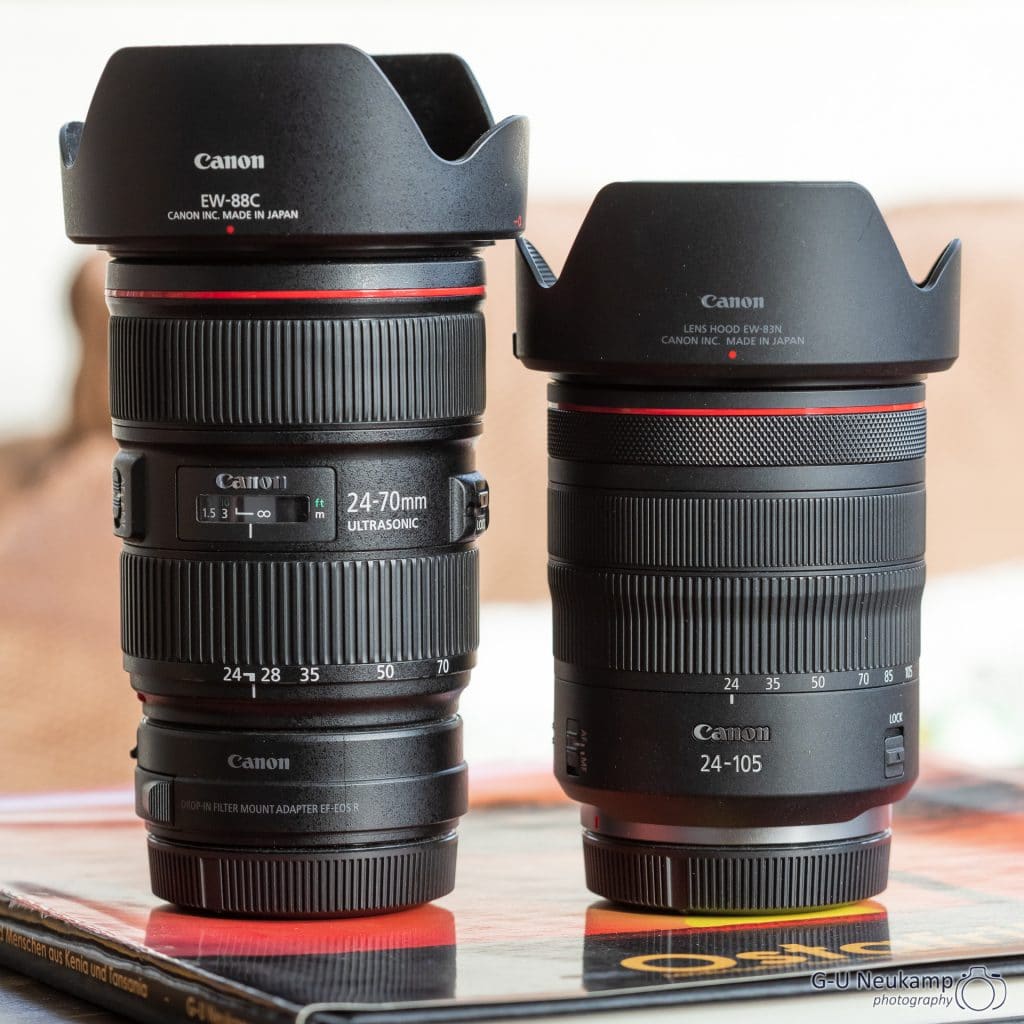
As with with my test of the 24-105 lenses, I wanted to see for myself how the lens performs in real life in my hands compared to the RF 24-105 f/4L. Again, this test is not highly scientifically standardized, in that the website the-digital-picture.com offers more accurate comparisons. But I just wanted to see how I personally get along with the lenses and which one is better suited for my purposes.
Sharpness and contrast
As a test scenario, I have chosen the same small scene from our garden as in the test of the 24-105mm lenses. Admittedly, it is quite bleak there now in winter. As before, I mounted the camera on a stable tripod. The pictures were taken with self-timer and first electronic shutter curtain to avoid vibrations as far as possible.
24mm
First of all, I compared the two lenses at 24mm focal length. I imported the RAW images with both lenses in Lightroom with the default setting, put them side by side in the comparative view without any further manipulations and took screenshots. The RF 24-105 f/4L IS version is on the left in each picture, and the EF 24-70 f/2.8L II version is on the right.
In the overview image, there are no significant differences at first glance except for a slight vignetting with the 24-105, and the framing is also mostly the same:
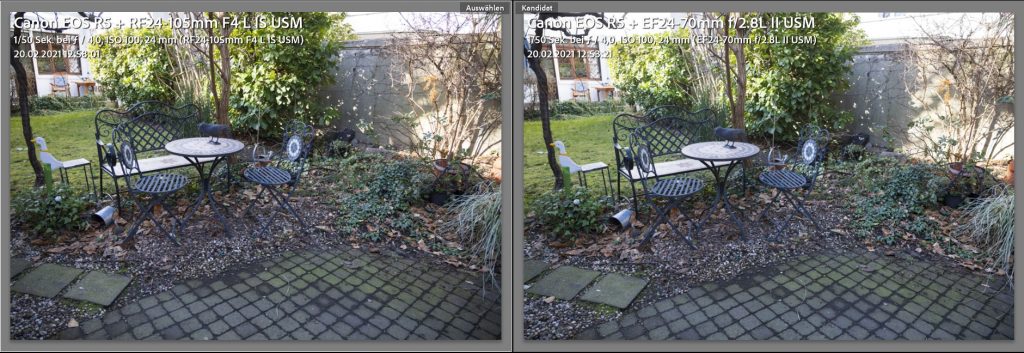
The EF is minimally sharper and has more contrast in the center than the RF:
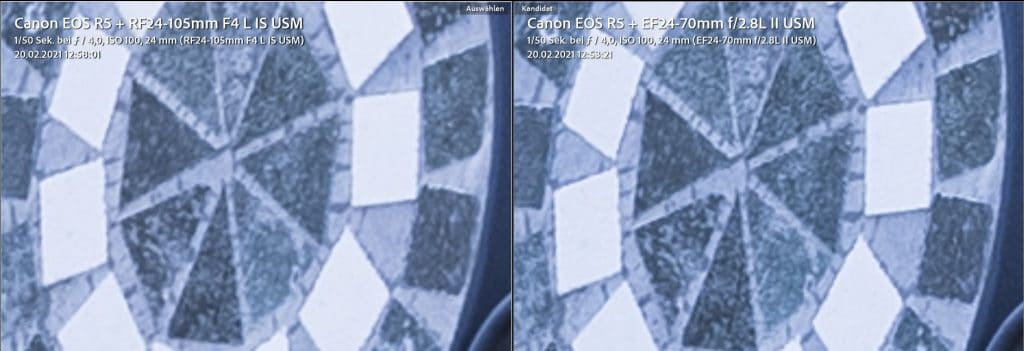
By the way, this remains true at open aperture - the EF 24-70 f/2.8L II is superbly sharp at f/2.8 and still slightly better than the RF 24-105 f/4L IS at f/4:
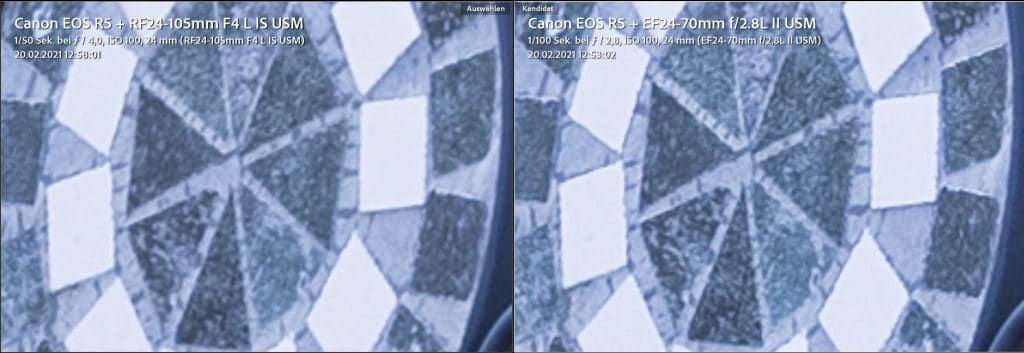
The difference is more noticeable at the left edge:
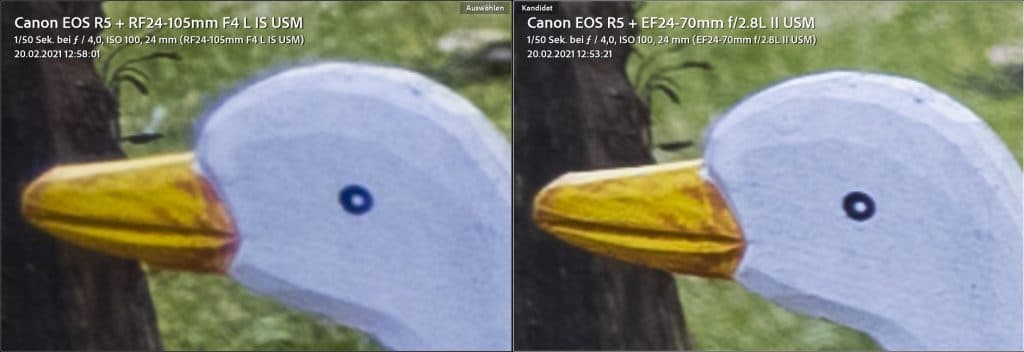
Differences are clearly visible in the branches at the upper right edge. The significant chromatic aberration of the RF 24-105 is striking. The EF also shows significantly more details in the branches:
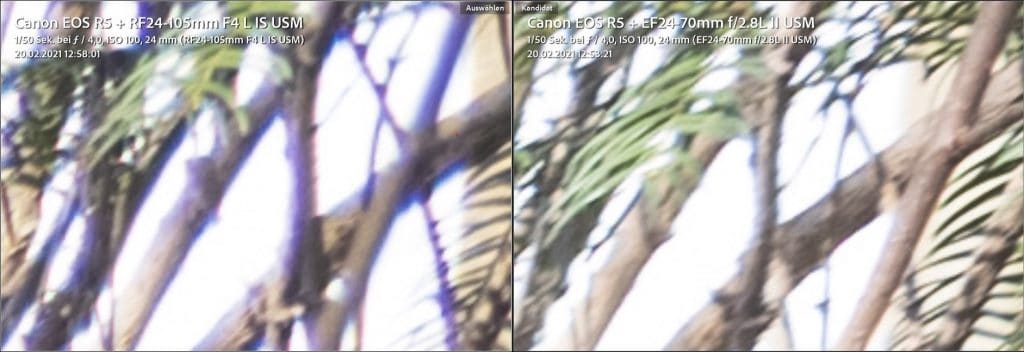
At f/11, the difference is reduced, but still present:
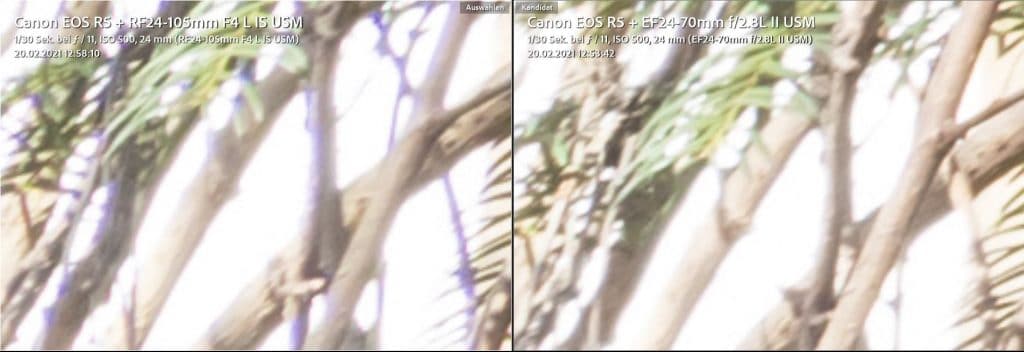
By activating the automatic lens correction in Lightroom at f/11, the difference becomes much smaller:
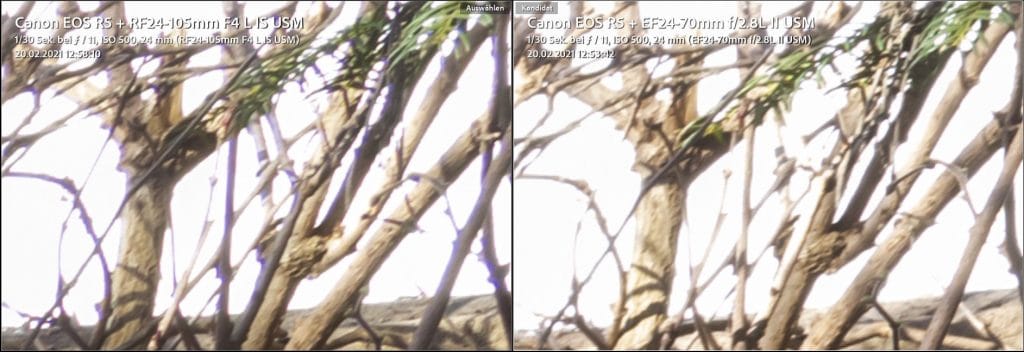
All in all, at the shortest focal length of 24mm, my adapted EF 24-70 f/2.8L II is sharper and more contrasty than my RF 24-105 f/4L IS in all ranges and at all apertures on my EOS R5. It also vignettes less than the RF at f/4. Sharpness at 24mm is slightly better in the center, but much better at the edges than with the RF 24-105 f/4L IS. Stopping down reduces the differences in quality.
In addition, the RF has much more pronounced chromatic aberrations that do not disappear completely with the correction algorithms in Lightroom. Overall, the images subjectively look a bit clearer and crisper to me with the EF.
50mm
Another comparison at 50mm focal length from the same position, again at aperture 4: On the left side of the picture you can see the RF 24-105 f/4L, on the right side the EF 24-70 f/2.8L II. First I want to show the whole image, focused again on the back of the chair:
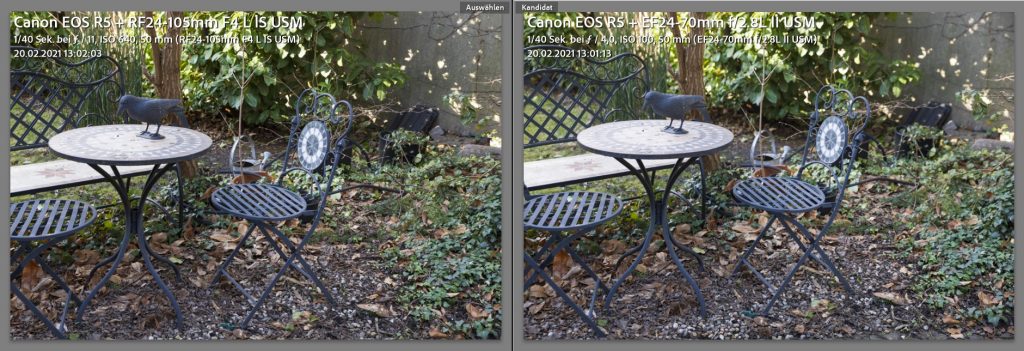
In the center, even when magnified to 400%, there is not much difference in both lenses at 50mm focal length, but the EF again looks a touch more contrasty and sharp:

There is also hardly any difference visible at the leaf in the lower left of the frame:
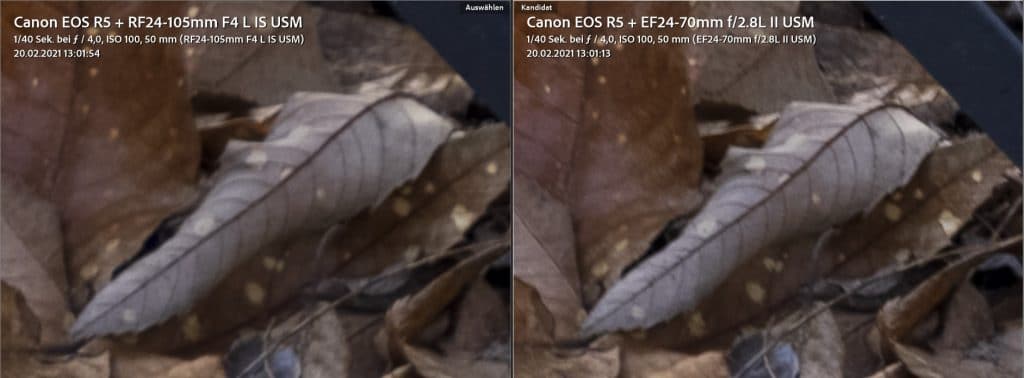
Overall, the difference between the two lenses at 50mm focal length and f/4 is minor, the EF has at best minimal advantages, so I did not test it any further. But: the EF can still be used at 50mm with aperture 2.8!
70mm
Now another test with the longest shared focal length of both lenses. First again the complete frame at f/4, the focus is again on the back of the chair:
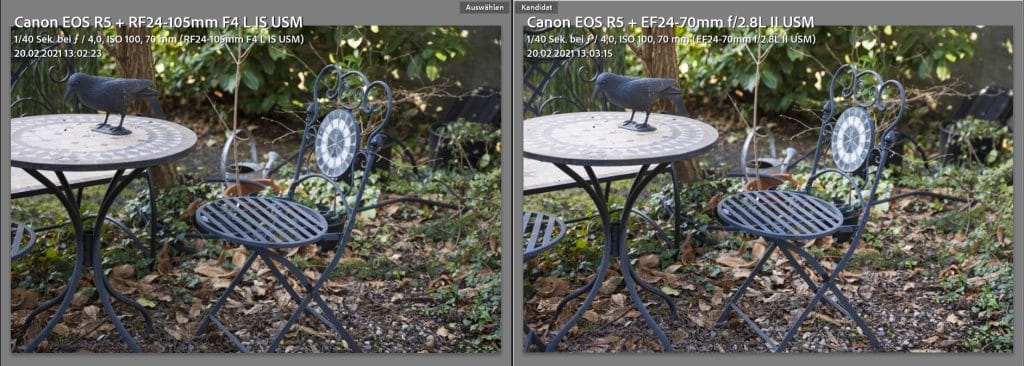
Again, no significant difference can be seen on the overview. With the 24-105, you can only see a slightly more pronounced vignetting at the corners. In addition, the framing of the EF is a bit wider than that of the RF set to 70mm. Now again a crop of the back of the chair at 400%:
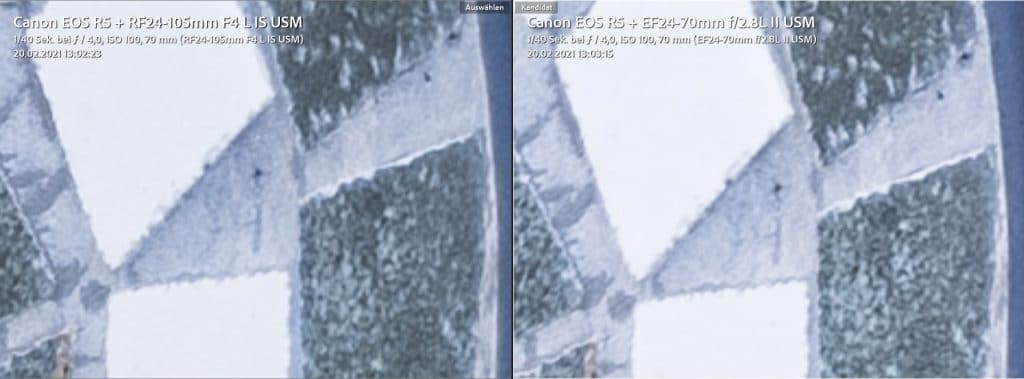
Even on close inspection, I can’t see any significant differences here, both lenses are sharp and contrasty. Unfortunately, the scene is also not suitable for judging the edge sharpness of the lenses, since all objects on the edges are out of the focus plane.
Therefore, I’ ll show you an example from a winter walk in the snowy town of Warburg a few days ago. For comparison, I also had both lenses with me on that walk:
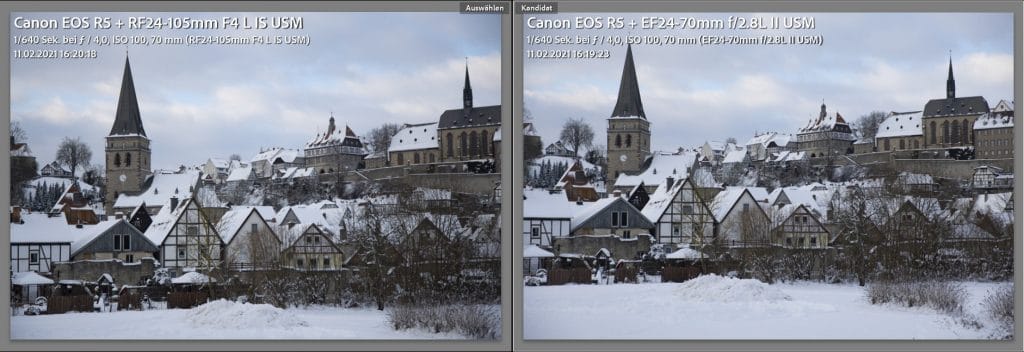
Here, you can also see, that the field of view of the EF 24-70mm is a bit wider than with the RF 24-105 set to 70mm. In the center of the image, the EF 24-70 F/2.8L II is a bit sharper again now and also has more contrast than the RF 24-105 F4L IS:
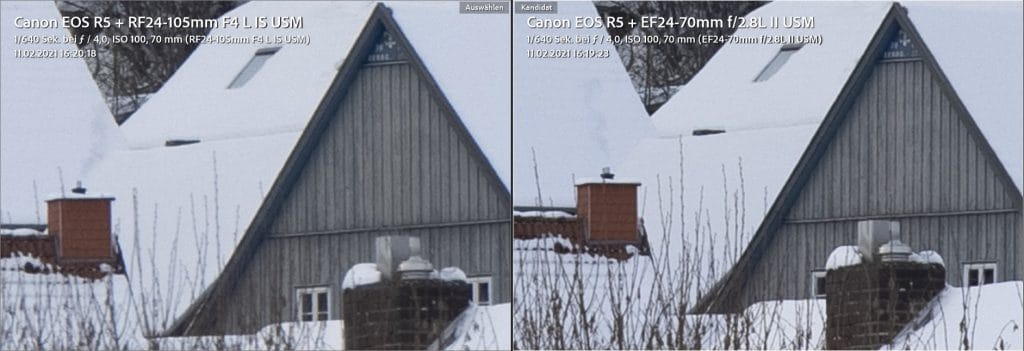
But the tree at the left edge appears much sharper with the EF 24-70 f/2.8L II:
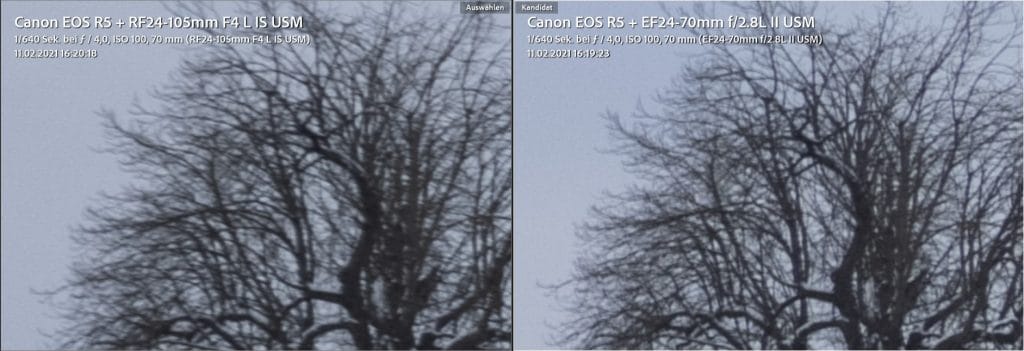
So overall, even at 70mm, my EF 24-70 f/2.8L II is the sharper and higher contrast lens.
Image stabilization
The new RF 24-70 f/2.8L IS lens, as the last two letters of the model name reveal, has a built-in optical image stabilizer, as does the RF 24-105 f/4L IS I tested here.
On the other hand, the EF version of the 24-70 f/2.8L II that I tested here does not feature a built-in optical image stabilizer. However, it can use the sensor based stabilizer built into the new Canon EOS R5 and R6 cameras.
According to Canon’s advertising statement, the new RF lenses in cooperation with the sensor based stabilization of the R5 and R6 bodies should allow sharp shots at up to 8 f-stops longer exposure times than without stabilization. Interestingly, according to Canon, this also applies to some lenses without built-in optical stabilizer, such as the RF 28-70 f/2. Thus, the sensor-based stabilization of the EOS R5 and R6 seems to be very effective on its own.
I was now wondering what is possible with my EOS R5’s sensor-based stabilizer in combination with the EF 24-70 f/2.8L II and compared it to my RF 24-105 f/4L for that purpose.
My test setup
For this purpose, I took 12 free-standing shots each of the EOS R5 box with both lenses from the same position at 70mm focal length with exposure times of 0.5 and 1 second each. Below you can find the shots of the series placed one below the other. I have arranged the center crop sections (each 800 pixels wide) sorted by sharpness one below the other. An exposure time of 0.5 seconds at 70 mm corresponds to the rule of thumb:
Blur-free exposure time corresponds to 1/focal length
to a stabilization of slightly more than 5 stops. In my simple comparison, the hit rate of the EF 24-70 f/2.8L II’s stabilization at 0.5 second exposure is somewhere between the RF 24-105 f/4L IS’s results at 0.5 and 1 second. Thus, in my hands, the stabilization of the adapted EF lens on the EOS R5 is only about 0.5 stops less effective than with the native optically stabilized RF lens:
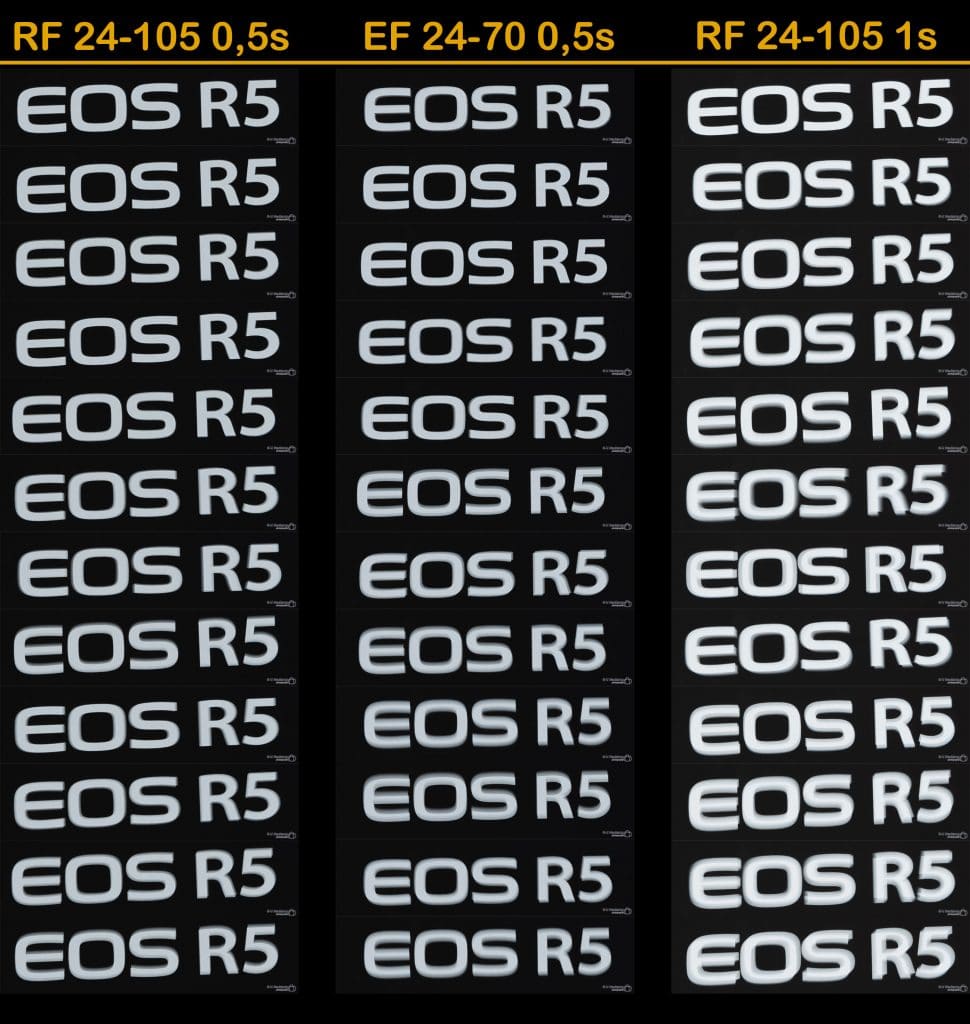
Bokeh - object isolation
Since both a 24-70 and a 24-105 standard zoom are certainly used very often for portraits, the so-called “bokeh”, i.e. the quality of the blur, is very important with these lenses. It is to be expected that the larger aperture of the EF 24-70 f/2.8L II will achieve an improved quality of isolation of an object than the aperture 4 of the RF 24-105 f/4L IS.
Since my family members and also our cat did not want to pose, our stuffed monkey from my test of the denoising with DxO PhotoLab 4 had to pose again. But he did this again gladly and without grumbling for me 😉
Of particular interest in portraiture is, of course, the longest focal length the lenses have in common, so I set the EF 24-70 f/4L II to 70mm. As noted above, set at 70mm it provides a wider angle of view than the RF 24-105 f/4L IS set to 70mm. To ensure a fair comparison, I set the zoom range on the RF so, that the framing of both lenses was the same. With my RF 24-105 f/4L IS, this was the case at a focal length setting of 63mm. I do not know which lens is “right” here. But it is also a known fact that internally focused zoom lenses tend to shorten the effective focal length at close range.
Again, I took all shots with the Canon EOS R5 mounted on a tripod from the same position with self-timer and imported the RAW files into Lightroom with the default settings without any post-processing. As already mentioned above, I again present screenshots of the comparative view in Photoshop Lightroom. Again, each one shows the shot with the RF 24-105 f/4L IS on the left and the one with the EF 24-70 f/2.8L II on the right. First the comparison of both lenses at open aperture:
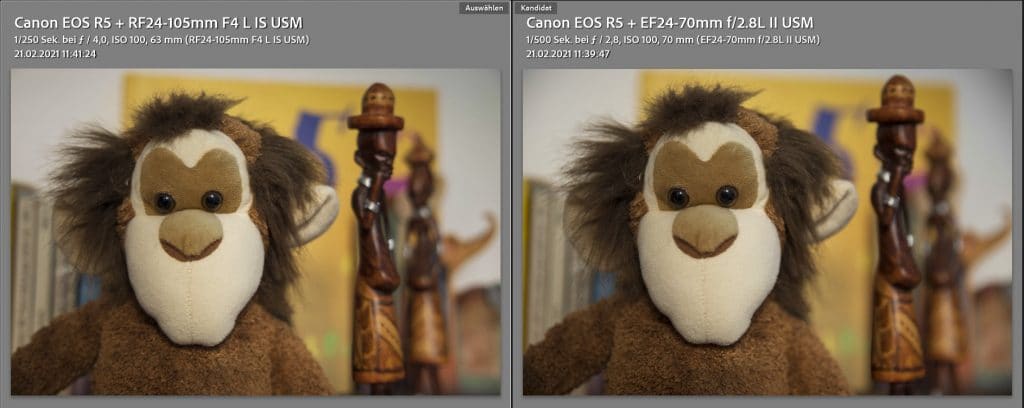
In direct comparison, the EF 24-70 f/2.8L II produces a visibly better object isolation and bokeh, as expected. This can be clearly seen in the wooden figures and the books in the background.
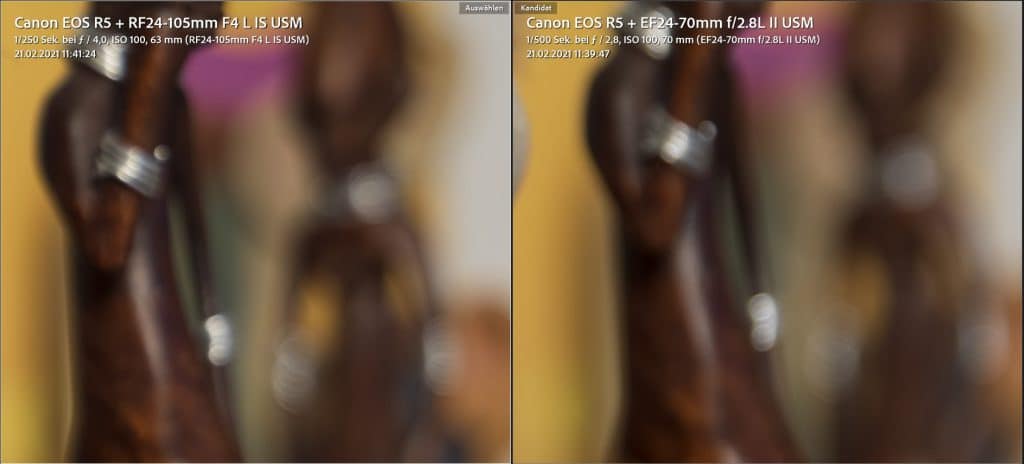
What is noticeable is a much more pronounced vignetting of the background with the EF 24-70 f/2.8L II, but the RF 24-105 f/4 also vignettes visibly at open aperture. However, the vignetting can be corrected very easily and effectively for both lenses in Adobe Lightroom by activating the automatic lens profile correction:
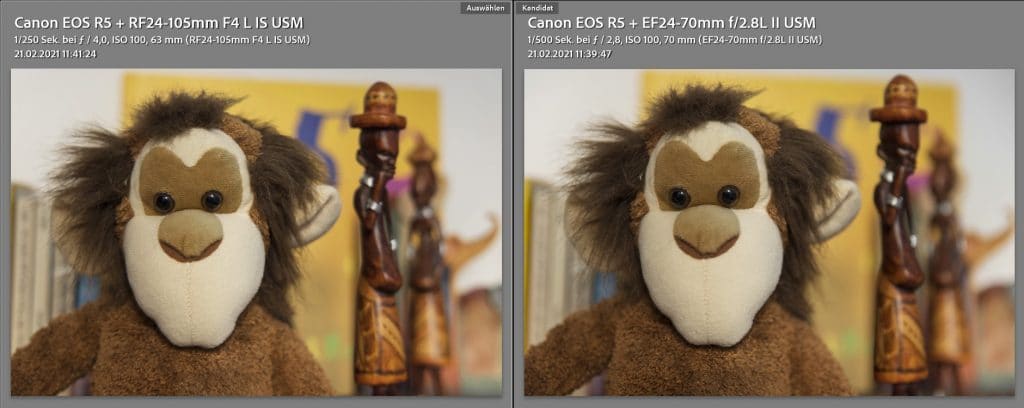
However, since I usually even welcome a little vignetting in portraits, I usually leave the automatic lens profile correction in Lightroom turned off.
At the same aperture 4 and 11, the two lenses hardly differ in their rendering of the out of focus areas:
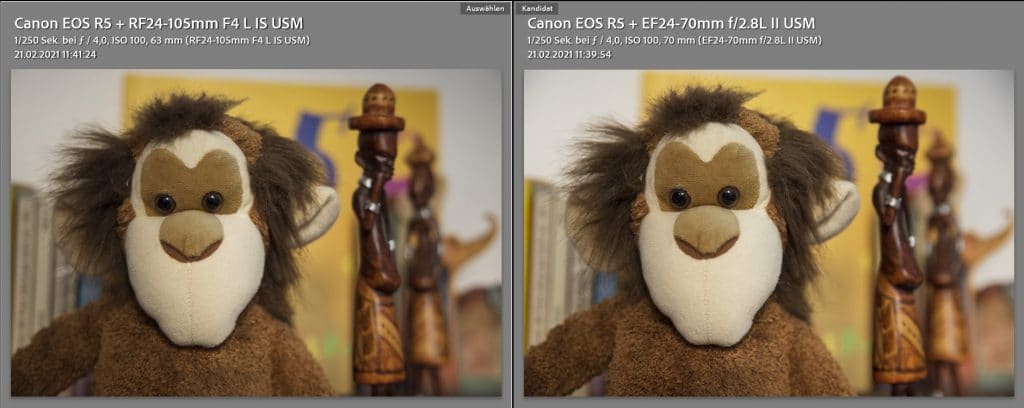
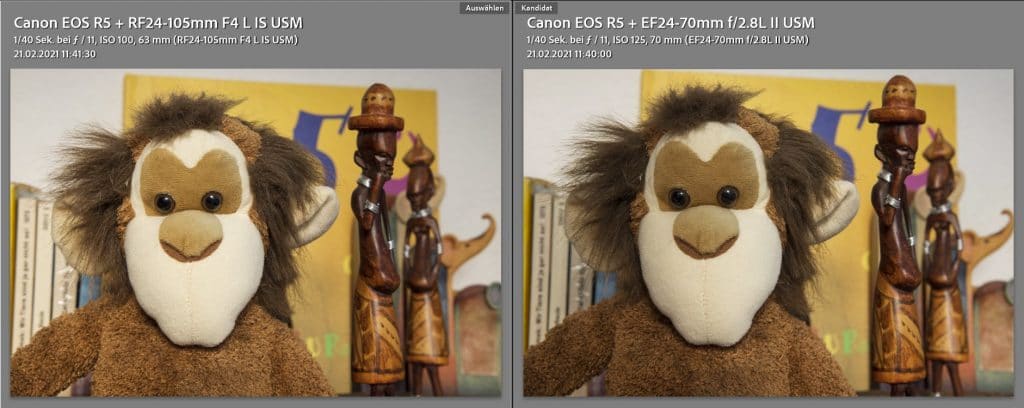
But: the RF 24-105 f/4L IS still has a much larger focal length range available. Since the depth of field decreases with increasing focal length at the same image scaling and the same aperture, it should also be possible to achieve a better object isolation and Bokeh, right?
To try this out, I took a few more shots with the 24-105 from a little further distance, making sure that the stuffed animal’s head was shown at about the same size:
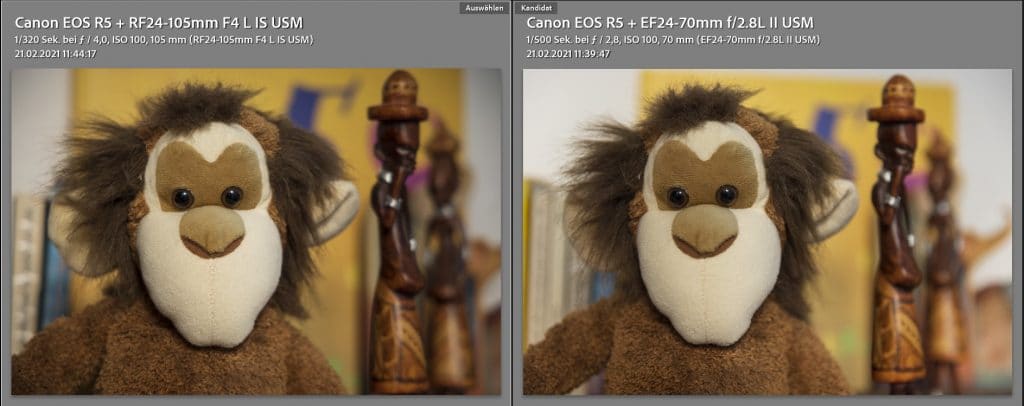
Here, the object isolation and rendering of the out of focus areas of the two lenses seem to be comparable.The slight compression of the perspective can be seen nicely in the shot with 105mm focal length on the left: The wooden figures appear to stand a bit closer to each other. The RF 24-105 f/4L IS again vignettes relatively noticeably at 105mm. Both lenses now deliver comparably beautiful blur gradients, as can be easily seen in the 50% crops:
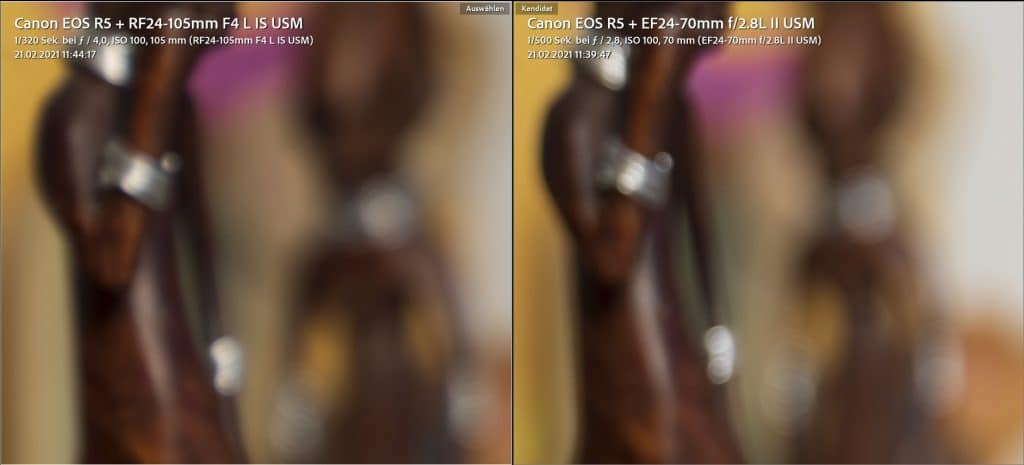
Conclusion
So, what is the core message of this very subjective test?
First of all, the most important thing: both lenses are very usable, you won’t go wrong with either. In my opinion, the EF 24-70 f/2.8L II - especially at 24 and 70mm - is still a bit sharper and richer in contrast than the RF 24-105 f/4L IS. But the RF is clearly superior in the focal length range from 71mm upwards 😉
The somewhat less effective stabilization effect due to the pure sensor stabilization on the Canon EOS R5 / R6 of the EF 24-70 f/2.8L II is compensated in many situations by the one f-stop wider aperture. On the other hand, the RF 24-105 f/4L IS can compensate for the reduced object isolation at open aperture of only f/4 in many situations by stepping back from the subject and choosing the longer focal length.
The RF 24-105 f/4L IS is more compact and lighter on the EOS R5 and R6, but I can also use the EF 24-70 f/2.8L II on my EOS 5DSR.
With the Drop-In Filter Mount Adapter EF EOS R, I can save a separate polarizing or ND filter for the wider 82mm filter thread of the EF 24-70 f/2.8L II, as I can now use these two drop-in filters with all my EF lenses from 14 to 600mm focal length (at least with the EOS R5).
For now, I will keep both lenses. The RF 24-105 f/4L IS will remain on the EOS R5 when I’m traveling with “small baggage”, i.e. just one camera and only 1 or 2 lenses. Then the additional 35mm focal length is sometimes quite helpful. Otherwise I will tend to use the EF 24-70 f/2.8L II and leave the EF EOS R drop-in filter mount adapter permanently attached to the R5. I can then use all my lenses on the EOS R5 and the EOS 5DSR and do not have to constantly attach and detach the adapter.
But the most important take home message might be: If you already own a decent Canon EF lens, it can also easily be used with the perfectly working RF-EF adapter on the EOS R cameras. It will then usually perform just as fine as it did before with the Canon DSLR cameras. A new purchase of an RF lens is then not necessary.
By choosing a used EF lens, you can also save a lot of money compared to the still very high prices of the RF counterparts, which can be invested in additional lenses or even higher-quality (e.g. an EF f/2.8 zoom instead of an RF f/4 zoom) optics. So I bought myself in the meantime the excellent EF 100-400 f/4,5-5.6L IS II second-hand and spent only 1/3 of the price of the comparable RF 100-500. A detailed report on this with many sample pictures can also be found here on this website.
*= Affiliate Link

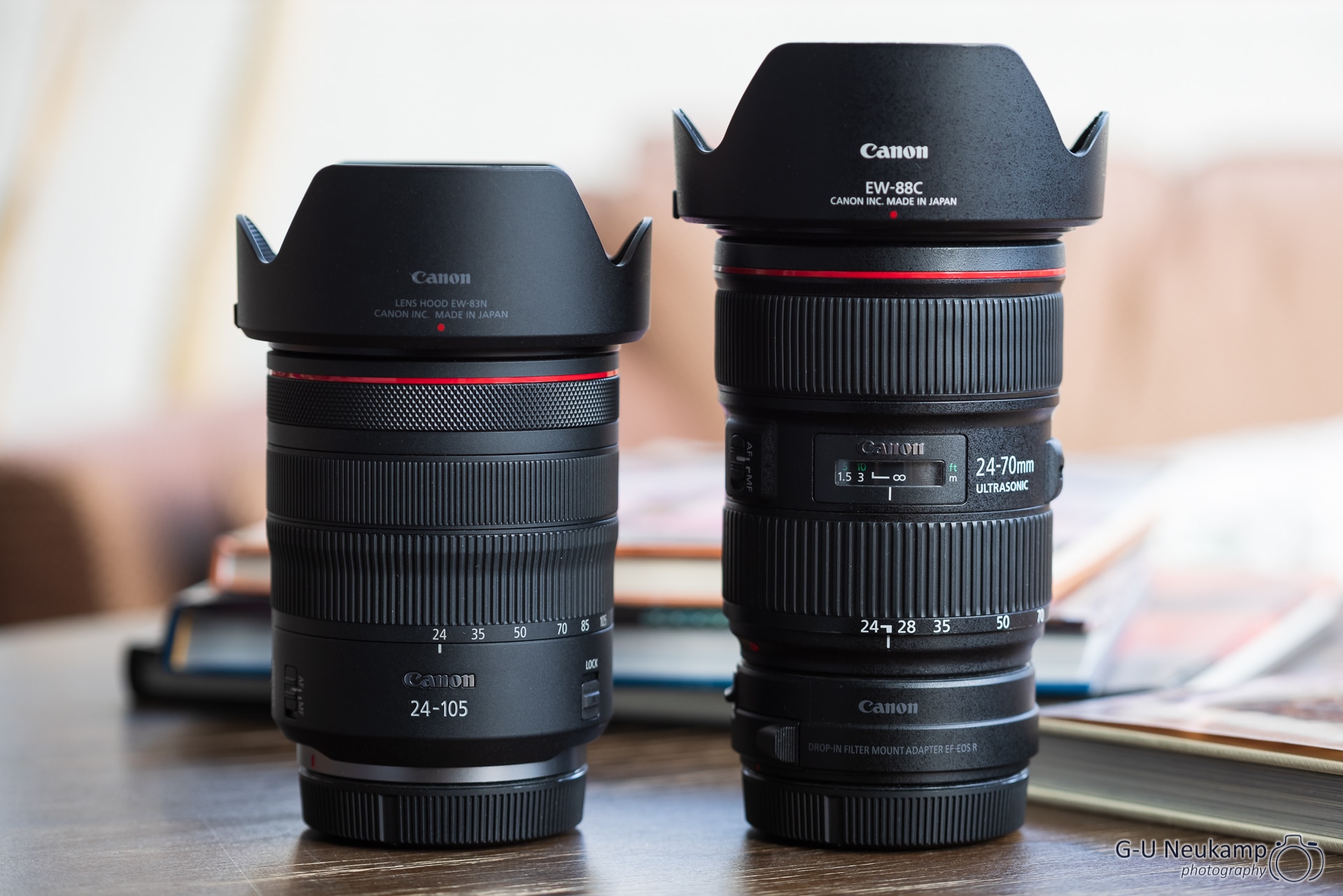
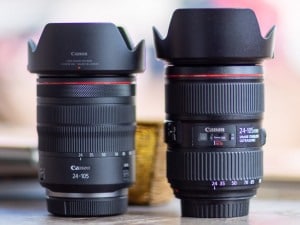

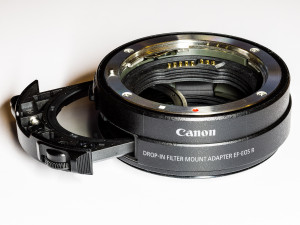
Thank, You! It helps me choose my next lense !
Thank you this is a great and very useful review. Even though its not head to head it answers a lot of questions about the relative performance of the lenses.
In your tests, the EF 24-70 is stopped down. If you stop down the RF 24-105 to f/5.6, the difference continues present?
In the report, I only compared the lenses stopped down at f/11 at 24mm focal length, and the EF 24-70 performed better. The differences decrease in the longer focal length ranges. Without having done further scientific tests, in my experience I do think that the EF 24-70 f/L II performs better in its range than the RF 24-105, which is also reflected in the list price. Still, the RF 24-105 is not a bad lens, in its price range it is clearly a worthy buy. Both lenses are perfectly usable at maximum aperture.
In any case, I usually prefer to use the EF 24-70 over the RF 24-105 when I’m traveling with large photographic equipment. However, I still keep the RF and use it when I’m traveling with little equipment (i.e. camera and only one lens), then the extended telephoto range up to 105mm is also helpful.
So what’s your verdict about these two after another year?
Did the compactness of the RF outshine the size and image quality of the EF?
A used EF 24-70 is a little cheaper than a new RF 24-105 and I’m on the brink of choosing one of them…
So, after a good year, I can say that I will keep both lenses. I take the RF24-105 when I only want to carry a small amount of equipment, i.e. only the camera and one lens. On larger shoots, like my recent trip to Kenya, I only pack the EF24-70, because I can use it on both my 5DSR and R5 bodies. On safari, my drop-in EF-RF mount adapter worked well. This stayed on the R5 for the entire trip, since I only had EF lenses with me. Despite the very dusty environment, the clear glass insert did a very good job of preventing dust buildup on the sensor. If I didn’t have either of them, the EF 24-70 would probably be my first choice because of the affordable second-hand price.